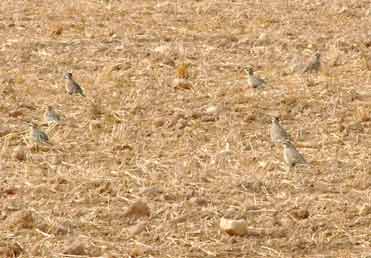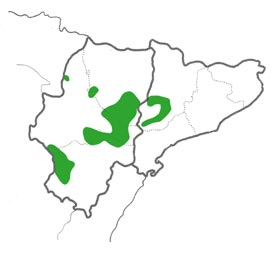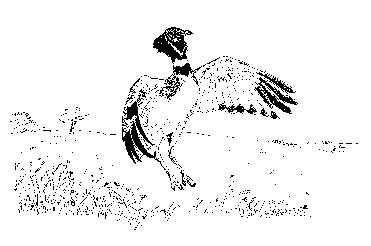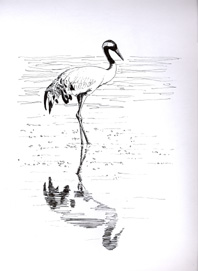The price of petrel has soared so that even spendthrifts quail at the thought of filling the tank.
At the same time high mortgages are forcing many to sell their residence in the house mart in the local paper.
Everyone knows we’re in for a ruff time. It’s so tempting to snipe at banks and investors for causing this crisis, but that is knot really going to help things much.
So before your life takes a serious tern and you start robin’ other people’s possessions, try following this simple advice:
· Do by all means have a good grouse about the world economy if that makes you feel better
· In practical terms it’s best to swallow hard, go to the pub, have a nightjar or two, followed by a good, long P.aristotelis.
· And remember one essential thing: birding is for life, so never even think about ditching your hobby.
Can you spot the 14 birds in this text and its title?
Posted in General | No Comments »
This is a typical autumn scene from the drylands of Lleida:

No, not partridges or larks, they are Dotterel Charadrius morinellus.
This year the lucky participants on the famtrip organized by the Catalan Tourist Board were treated to the sight of a flock of 18 Dotterels on the drylands of Alfés, Lleida, Spain. We were watching Thekla Larks when the Dotterel literally flew over our heads and landed in the field in front of us. I had already told the famtrip participants that we were in a good area for migrating Dotterel, but also that due to the nature and brevity of our visit we were not going to look for them.
So it was very nice of the Dotterel to come looking for us!
The Alfés Dotterels already featured in my first book. Part of the text in “Where the birds are in northeast Spain” concerning the Dotterel reads as follows: “flocks that vary in size, but rarely in excess of 50 birds seek out and congregate in ploughed or stubble dryland cereal fields, alternating with smaller patches of fallow land.”
Their presence in the drylands around Lleida is common knowledge now, but not so back in September 1994. Then I almost fell off my motorbike when they crossed the track in front of me on the edge of the thymefields of Alfés.
In the following years I compiled a modest list of personal observations of Dotterels at Alfés:
17 birds on 07/09/94
13 birds on 09/09/95
11 birds on 05/09/96
9 birds on 10/09/97
6 birds on 01/09/99
2 birds on 09/10/99
20 birds on 29/08/00
4 birds on 30/08/01
There’s more, but really all that you need to know to see Dotterels in northeast Spain can be read in “Where the birds are in Northeast Spain”. Detailed information about birding the drylands of Alfés can be found in the drylands of Lleida itinerary on the BirdingInSpain.com website.
Where to stay to be close to the Dotterels, Pin-tailed Sandgrouse, Black Wheatears, etc. of Alfés? La Garbinada.
Posted in Birds in Spain | No Comments »
Little Bustard Tetrax tetrax
 The Little Bustard is a localised resident bird in northeast Spain, breeding mostly in the Ebro valley drylands in Catalonia and Aragón. After breeding the Little Bustard gradually deserts dryland areas and disperses around the surrounding areas, with major concentrations preferring alfalfa fields. Large winter flocks sometimes in excess of 1,000 birds have been found in some years, particularly in the area between Balaguer and Tàrrega.
The Little Bustard is a localised resident bird in northeast Spain, breeding mostly in the Ebro valley drylands in Catalonia and Aragón. After breeding the Little Bustard gradually deserts dryland areas and disperses around the surrounding areas, with major concentrations preferring alfalfa fields. Large winter flocks sometimes in excess of 1,000 birds have been found in some years, particularly in the area between Balaguer and Tàrrega.
 BirdingInSpain.com birding itineraries where Little Bustards can be found in the breeding season: Drylands of Lleida, Monegros Alcolea and Candasnos, Monegros Bujaraloz.
BirdingInSpain.com birding itineraries where Little Bustards can be found in the breeding season: Drylands of Lleida, Monegros Alcolea and Candasnos, Monegros Bujaraloz.
Posted in Birds in Spain | 1 Comment »
Montsonís is a tiny village in Montsec, Lleida, Spain, painstakingly and tastefully rebuilt from the depopulated ruins that existed no less than 30 years ago. Ramon and Carme, the directors of Castellsdelleida.com are the driving force that literally raised this village from its ruins.
Two birders from Washington state were booked in with me at Montsonís for a day’s guided birding around Montsec, but some confusion reigned momentarily, as no fewer than 6 birders, all from the USA, presented themselves at the same time! As it turned out the extra 4 were from the eastern seaboard, and had arrived at Montsonís by following my recommendations in “Where the birds are in northeast Spain”.
I turned up at 8 in the morning as the “Easterners” were tucking into a hearty breakfast. They briefly informed me that they had already been to Belchite and seen the Dupont’s Lark, and that their objective of the day was Little Bustard, before reaching the high Pyrenees that same evening.
My two “Westerners” on the other hand were taking things more slowly, and were keen to walk and bird in the general area. In the usual manner of this birding business we “missed” some possible bird species while being surprised by a number of unexpected observations.
In the first category our initial walk failed to reveal Bonelli’s Eagle (they’ve been playing hide and seek with me throughout the course of this year, “now you see me, now you don’t”). The surprises went a long way to make up for the misses though: a melanistic Montagu’s Harrier (the last of the year) out on the plains, along with a solitary Little Bustard which in theory should have been elsewhere. 4 Honey Buzzards circling over Mont-roig and then surely the same 4 over the plains a little later. Bee-eaters and an old male Marsh Harrier on migration through the high passes. A large flock of Rock Sparrows in the fields and none in their usual breeding haunts.
And Green and Great Spotted Woodpeckers (try to imagine your first visit to North America and how you would feel about seeing a Flicker or two).
We had great weather and a couple of fine walks. It would be nice to know what our “Easterners” managed to find that day.
Posted in General | No Comments »
Located on a continental plateau at an altitude of around 1,000m Gallocanta lagoon is deservedly well-known for its role as a stopover and wintering site for thousands of Common Cranes Grus grus. The spectacle offered by these birds as they gather to roost on and around the lagoon, especially in February and March, is one that any visiting birder worth his binoculars could hardly fail to appreciate.

The first-time visitor should know a few things about this site when planning a winter visit. Firstly, it can get very cold here in the winter, so make sure you bring your woollies! Secondly, the level of water in the lagoon depends entirely on rainfall, and that has been scarce or intermittent in recent years, so don’t be surprised if the water in the “lagoon” is only a at a fraction of its capacity.
However, only the fickle and faint should be put off by the above. Apart from the Cranes and other waterbirds there may be on the lagoon itself, there are a lot of interesting birds that can be found on Gallocanta’s shores and in the surrounding area. These include a small but regular wintering population of Great Bustards, Black-bellied Sandgrouse, Calandra Lark, Thekla Lark, Golden Eagle, Hen Harrier, Red Kite, Griffon Vulture…there are even small numbers of Dupont’s Lark if you care to try and find them.
For more information see the Gallocanta itinerary in the sites and itineraries section of the BirdingInSpain.com website.
Oh yes! And don’t miss Eloïsa Matheu’s wonderfully atmospheric recording on the same page.
Posted in Photos and Places | No Comments »
In response to the growing demand for the answers to the first raptor silhouettes poster there is now a new special feature in the free downloads section of the BirdingInSpain.com website. More raptor silhouettes! Are you up to the challenge? Try your hand, but don’t expect any clues or answers just yet.
Posted in General | No Comments »
Something for readers of Spanish:
Agosto. Tiempo de las vacaciones y la dispersión ciudadana. 5 compañeros, todos aficionados alocados a la observación de las aves, decidimos por una aventura marina, alquilamos un barco con capitán incluido y nos lanzamos mar adentro desde el puerto de Gijón, rumbo al norte.
Era un día soleado, con poca brisa y un mar muy calmado, como lo había visto muy pocas veces antes nuestro experimentado capitán, Miguel. Ahí fuera esperaban un mar de satisfacciones: paíños europeos, alcatraces atlánticos, pardelas cenicientas, pichonetas, sombrías y mediterráneas, los págalos grande y pomarino, incluso dos jóvenes charranes rosados.
A las 25 millas de la costa girábamos para el cabo de Peñas y justo en aquel momento, a los límites de nuestra incursión en el golfo de Vizcaya, 3 figuras, 3 fascinantes fantasmas, aparecieron de la nada y siguieron acercándose silenciosamente a nuestra barca. Momentos…y entonces un grito de emoción llenó el aire y nos devolvió la respiración “¡Sabini! ¡Son Sabini!”. Era cierto. 3 inmaculados gaviotas de Sabine, todos adultos, acababan de sobrevolar nuestras afortunadas cabezas antes de desdibujarse en el azul de mar y cielo. Ellas inmutas, sin prisas con todo el océano por delante y por detrás; nosotros llenos del momento, regalados con un recuerdo indeleble.
Creo que siempre recordaré el 18 de agosto de 1997, el día en el cual observamos estas 3 figuras, la vanguardia de una migración que toma lugar año tras año lejos del ruido mundano, allá entre los páramos silenciosos del océano.
Posted in General | No Comments »
A couple of Short-toed Eagles, 2 Pallid Swifts, lots of Alpine Swifts, a Golden Oriole, several Bee-eaters and lots of Hooded Crows is about the balance of 10 days casual birding while on a family holiday on the Dalmatian coast of Croatia, from Dubrovnik up to Paklenica National Park.
Fair’s fair – I wasn’t on a birding trip, and probably spent more time in the sea looking down on fish than in the countryside looking for birds. But compared to the birds I could have seen in northeast Spain, even casually, it seems a pretty poor tally. Maybe that goes to show that you have to go away to really appreciate what you have at home.
That seems to be particularly true about birds of prey. In Spain it’s relatively easy to see 10 or more raptor species in a single day. In the part of Croatia that we visited raptors were very thin on the ground. Likewise, last year I was birding in Morocco and the most common flying objects were not birds of prey but rather black plastic bags.
From now on then I’m going to try not to take raptors for granted – not even Griffon Vultures!
Posted in General | No Comments »


 The Little Bustard is a localised resident bird in northeast Spain, breeding mostly in the Ebro valley drylands in Catalonia and Aragón. After breeding the Little Bustard gradually deserts dryland areas and disperses around the surrounding areas, with major concentrations preferring alfalfa fields. Large winter flocks sometimes in excess of 1,000 birds have been found in some years, particularly in the area between Balaguer and Tàrrega.
The Little Bustard is a localised resident bird in northeast Spain, breeding mostly in the Ebro valley drylands in Catalonia and Aragón. After breeding the Little Bustard gradually deserts dryland areas and disperses around the surrounding areas, with major concentrations preferring alfalfa fields. Large winter flocks sometimes in excess of 1,000 birds have been found in some years, particularly in the area between Balaguer and Tàrrega. BirdingInSpain.com birding itineraries where Little Bustards can be found in the breeding season: Drylands of Lleida, Monegros Alcolea and Candasnos, Monegros Bujaraloz.
BirdingInSpain.com birding itineraries where Little Bustards can be found in the breeding season: Drylands of Lleida, Monegros Alcolea and Candasnos, Monegros Bujaraloz.